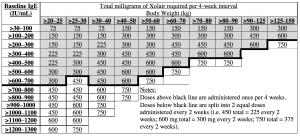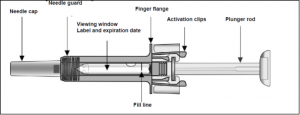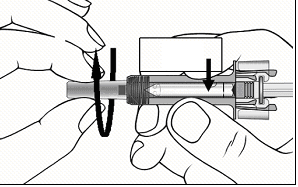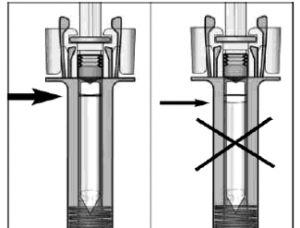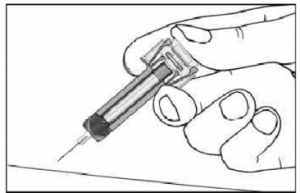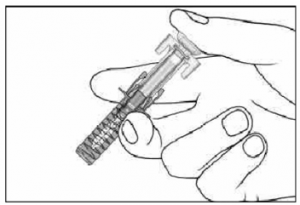Clinical Recommendations for The Use of Omalizumab In Severe Asthma in Adults
Download the pdf document here: Omalizumab Recommendation Version 6 (May 2021; revised format)
About the treatment
Introduction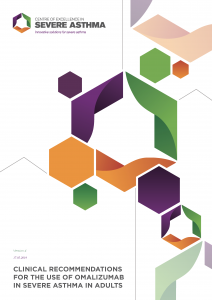
Omalizumab (Xolair) is indicated as an add-on therapy for severe allergic asthma. In children aged 6 to <12 years, omalizumab is indicated as an add-on therapy to improve asthma control in patients with severe allergic asthma, who have documented exacerbations despite daily high-dose ICS and with IgE levels in the recommended dose range. In adults and adolescents ≥12 years of age, omalizumab is indicated for the management of patients with moderate to severe allergic asthma, who are already being treated with maximal recommended asthma therapy, and who have serum IgE levels (≥ 30 IU/mL) and positive allergen-specific IgE
Mechanism of action
Omalizumab is a recombinant, DNA-derived, humanised, monoclonal IgG1 antibody directed against immunoglobulin E (IgE). IgE is produced by the immune system and is involved in activation of immune responses during allergy.
Omalizumab binds to free human IgE in the blood and interstitial tissues, as well as to receptor-bound IgE on immune cells. The binding of omalizumab blocks “cross-linking” of IgE receptors on immune cells, and prevents allergic activation of these cells. This process reduces allergic responses and recruitment of immune cells into tissues.
Pharmacodynamic effects
Following single, subcutaneous administration, omalizumab reaches peak serum concentrations after around 6-10 days. In clinical trials, free IgE levels are reduced in a dose-dependent manner within 2 hours of subcutaneous dosing. Average decreases were 84-99% of baseline. Serum total IgE levels increased an average of 4-fold post-dosing due to formation of omalizumab-IgE binding complexes. Following discontinuation of omalizumab dosing, increases in total IgE and decreases in free IgE were reversible. [Content extracted from Xolair Production Information document]
Clinical Benefit
In a meta-analysis, exacerbation frequency was reduced, with an odds ratio of 0.55 (95% CI; 0.46-0.65)(1). The absolute reduction in risk of exacerbations fell from 26% to 16%. Hospitalisations were also reduced (OR: 0.16; 95%C CI: 0.06-0.42). In addition, more patients were able to reduce ICS treatment. No significant reduction in OCS was observed.
PBS eligibility for Omalizumab access
In Australia, omalizumab can only be prescribed by a respiratory physician or allergist via S100 Authority prescription in accordance with specific application criteria. After discussing the risks, benefits, and alternatives to omalizumab, patients must complete the acknowledgement of understanding using the PBS initial application form. Patients require review of omalizumab efficacy and safety, by the prescribing respiratory physician, at 22 to 26 weeks after the first dose. For second and subsequent courses, the assessment should be undertaken after 18 to 22 weeks of treatment. Omalizumab is considered a high-risk medicine and must be administered with an independent second person check.
Criteria for eligibility:
[Accessed 13 March 2020; please check https://www.servicesaustralia.gov.au/severe-asthma?context=23021 for any recent changes]
| CHECKLIST | |
| Patients must be treated by a respiratory physician, clinical immunologist, allergist or general physician experienced in the management of patients with severe asthma
Age ≥ 12 years (see separate eligibility criteria for children 6 to <12 years – https://www.servicesaustralia.gov.au/pb188 |
|
| The treatment must not be used in combination with and within 4 weeks of another PBS-subsidised biological medicine prescribed for severe asthma
|
|
| Has had asthma for at least 12 months AND
FEV1 ≤ 80% predicted documented on one or more occasions in the last 12 months AND
Past or current evidence of atopy, documented by skin prick testing or RAST or an in vitro measure of specific IgE that is no more than one year old AND
A total serum human immunoglobulin E (IgE) ≥ 30 IU/mL AND
Under the care of the same physician for 6 months OR
Diagnosed by a multidisciplinary severe asthma clinic team
|
|
| Has a diagnosis of asthma defined by standard clinical features, including (1 or more of the following):
a) FEV1 reversibility ≥ 12% and ≥ 200mL at baseline within 30 minutes after administration of salbutamol (200-400mg), OR b) Airway hyper-responsiveness (AHR) defined as >20% decline in FEV1 during a direct bronchial provocation test or >15% decline during an indirect test, OR c) Peak Expiratory Flow (PEF) variability of >15% between the 2 highest and 2 lowest peak expiratory flow rates during 14 days OR d) Patient must have a diagnosis of asthma from at least two physicians experienced in the management of patients with severe asthma |
|
| The patient has received optimised asthma therapy including adherence to high dose[1] inhaled corticosteroid (ICS) and adherence to long-acting beta-2 agonist (LABA) for at least 12 months and treatment with oral corticosteroids (OCS) (either as daily OCS for at least 6 weeks or a cumulative dose of oral corticosteroids of ≥ 500mg prednisolone equivalent in the previous 12 months)
|
|
| Failed to achieve adequate control with optimized asthma therapy, despite formal assessment of and adherence to correct inhaler technique, as indicated by:
a. Asthma Control Questionnaire (ACQ-5) score ≥2 AND b. One of the following experienced in the previous year: i. ≥1 admission to hospital for a severe asthma exacerbation, OR ii. ≥1 severe asthma exacerbation requiring documented use of systemic corticosteroids (OCS initiated or increased for at least 3 days, or parenteral corticosteroids) prescribed/supervised by a physician.
|
Some exemptions to the above treatment requirements, based on toxicity, are possible. See https://www.servicesaustralia.gov.au/severe-asthma-toxicity-criteria-and-severity-descriptors?context=23021 for details.
[1] For definitions of high dose ICS for adults, see http://www.asthmahandbook.org.au/
Safety profile
Omalizumab therapy is generally well tolerated, but there are some safety considerations, the most important of which is the rare, but potentially life-threatening omalizumab-associated anaphylaxis. Despite these concerns, omalizumab has been safely administered in the community setting in Australia and internationally.
Adverse reactions with omalizumab were observed (all studies with adult and adolescent patients 12 years of age and older) at a frequency of 6.6 % of patients, treated with active drug, during clinical trials [extracted from Xolair Product Information document].
The most commonly associated adverse drug reactions were injection site reactions, including injection site pain, swelling, itching and redness (1.7%) and headaches (1%). Other adverse reactions most frequently observed were weight increase (0.7%), urticaria (0.4%), fatigue, arm swelling, nausea, pharyngitis and skin rashes (all at 0.3%). Most of these events were mild or moderate in severity [extracted from Xolair Product Information document].
In clinical trials with patients 6 to <12 years of age, the most commonly reported adverse reactions were headache, pyrexia and upper abdominal pain. Most of the events were mild or moderate in severity.
The incidence of anaphylaxis associated with post-marketing use of omalizumab may be as high as 0.2% though other researchers have found the incidence to be much lower at 0.09% (2). The anaphylaxis risk requires this medication to be administered in a clinical setting that has access to trained health professionals with equipment and medications to treat anaphylaxis and cardiac arrest.
PRECAUTIONS [extracted from Xolair Product Information]
Contraindications: Hypersensitivity to omalizumab or any other component of the formulation.
Asthma-related adverse events or exacerbations may occur during treatment with omalizumab. Patients should be instructed to seek medical advice if their asthma remains uncontrolled or worsens after initiation of treatment with omalizumab.
Abrupt discontinuation of asthma medication after initiation of omalizumab therapy is not recommended. Reductions in medication doses, if warranted, should be gradual and performed under the supervision of a physician.
ADVERSE EFFECTS [extracted from Xolair Product Information]
Allergic reactions:
Local or systemic allergic reactions, including anaphylaxis, may occur. In post-marketing experience, anaphylaxis reactions have been reported following the first and subsequent omalizumab administrations. Although most of these reactions occurred with 2 hours after administration, some occurred beyond 2 or even 24 hours after injection. Medications for the treatment of anaphylactic reactions should always be available for immediate use following omalizumab administration. Patients should be informed that such reactions are possible and prompt medical attention should be sought if allergic reactions do occur.
Serum sickness and serum sickness-like reactions, which are delayed allergic type III reactions, have rarely been seen in patients treated with humanized monoclonal antibodies including omalizumab. The onset has typically been 1-5 days after administration of the first or subsequent injections, also after long duration of treatment. Symptoms suggestive of serum sickness include arthritis/arthralgia, rash (urticaria or other forms), fever and lymphadenopathy. Patients should be advised to report any suspected symptoms.
Churg-Strauss syndrome and hypereosinophilic syndrome:
Patients with severe asthma may rarely present systemic hypereosinophilic syndrome or allergic eosinophilic granulomatous vasculitis (Churg-Strauss syndrome), both of which are usually treated with systemic corticosteroids. In rare cases, patients on therapy with anti-asthma agents, including omalizumab, may present or develop systemic eosinophilia and vasculitis. A causal association between omalizumab and these underlying conditions has not been established. These events are commonly associated with the reduction of oral corticosteroid therapy. In these patients, clinicians should be alert to the development of marked eosinophilia, vasculitic rash, worsening pulmonary symptoms, paranasal sinus abnormalities, cardiac complications, and/or neuropathy. Discontinuation of omalizumab should be considered in all severe cases with the above-mentioned immune system disorders.
Other IgE-associated disorders:
Omalizumab has not been studied in patients with anaphylaxis, hyperimmunoglobulin E syndrome, allergic bronchopulmonary aspergillosis, food allergy or atopic dermatitis. Parasitic infestation may also result in elevation of serum IgE concentrations. In a study of patients with asthma who had been treated for gut parasites, the level of reinfection did not differ significantly between omalizumab and placebo groups and there were no serious or severe infections (3). There is no current evidence to suggest that parasitic infections are predisposed to by omalizumab.
Interpretation of serum IgE levels, skin patch and skin prick testing:
Patients treated with omalizumab have a rapid reduction in free IgE in the serum but an overall increase in the total serum IgE (commonly measured in clinical laboratories), which reflects free IgE and IgE bound by omalizumab. IgE measured following treatment cannot be used to guide treatment or dosing decisions.
Because omalizumab reduces free IgE in the serum and tissues, results of skin prick testing, patch testing, and RAST testing for hypersensitivity to potential allergens may be affected. A positive test to a potential allergen in a patient receiving omalizumab can be correctly interpreted as representing hypersensitivity to that allergen; however, a negative test in a patient receiving omalizumab may not be interpretable. Physicians are urged to use caution in interpreting such tests in patients receiving omalizumab.
Thrombocytopenia:
At serum concentrations in excess of maximum human exposure used in pivotal clinical trials, dose-related thrombocytopenia occurred in 2 out of 4 non-human primate species studied. The thrombocytopenia was more pronounced in juvenile animals. No omalizumab-related thrombocytopenia has been observed in clinical trials, but it has been reported in the post-market setting.
Omalizumab should be used with caution in patients with thrombocytopenia and patients with a history of thrombocytopenia. It is recommended that patients have a platelet count before commencing therapy with omalizumab and then periodically during treatment with omalizumab.
Pre-filled syringe, latex-sensitive individuals:
The removable needle cap of omalizumab solution for injection in pre-filled syringe contains a derivative of natural rubber latex. Although no natural rubber latex is detected in the removable needle cap, the safe use of omalizumab solution for injection in pre-filled syringe in latex-sensitive individuals has not been studied.
Use in Pregnancy (Category B1):
No studies have been performed in pregnant or breast-feeding women. Studies in cynomolgus monkeys do not indicate direct or indirect harmful effects with respect to pregnancy, embryonic/fetal development, parturition or neonatal growth at weekly doses up to 75 mg/kg SC about 10 times the maximum anticipated clinical exposure in adult patients, based on serum AUC). Because immunoglobulins are known to cross the placenta and the potential for harm to the foetus is unknown, caution should be exercised when prescribing Xolair to pregnant women.
Use in Lactation:
It is not known whether omalizumab is excreted in human milk. Because human IgG is excreted in human milk, and because the potential for absorption and harm to the infant are unknown, caution should be exercised when omalizumab is administered to breast-feeding women.
In order to assess the effect of omalizumab on late gestation, and to evaluate the placental transfer and milk excretion of omalizumab, doses of 75 mg/kg/week were administered subcutaneously to female cynomolgus monkeys. Transport of omalizumab into maternal milk was limited. The serum levels of omalizumab observed in dams, fetuses, and neonates are consistent with reported transport and distribution of IgG class immunoglobulins.
Dosage
Omalizumab dosing is determined based on a matrix of baseline IgE levels and body weight, administered by subcutaneous injection every two or four weeks.
Dosing tables are available in the Xolair product information document, available at the following link (accessed 06 December 2017; document updated 18 March 2021):
Figure 1: Dosing for patients aged ≥6 years (accessed 01 November 2017)
Doses greater than 750 mg were not studied in the pivotal clinical trials. However, observational studies provide evidence for the effectiveness of a ceiling dose of omalizumab (750 mg) in individuals above the recommended dosing criteria (4).
Storage
Omalizumab is stored with the syringe sealed in its outer box in the refrigerator between 2°C and 8°C. DO NOT FREEZE.
This medication should be stored in the refrigerator but needs to be administered at room temperature necessitating removal from refrigeration at least 20 minutes prior to injection.
For pre-filled syringes, the product may be kept out of the refrigerator, for a total of 4 hours at 25°C. If necessary, the product may be returned to the refrigerator for later use, but this must not be done more than once.
Procedures
The patient should remain for two hours after the first 3 omalizumab injections in an area under direct staff observation. For subsequent doses, an observation period of 30 minutes is required
Omalizumab should be administered by a registered health care professional (physician or registered nurse). Monitoring of patients after administration of biological agents is recommended.
Before the First Injection
Initial injections will generally be administered in the specialist’s clinic or private rooms, day hospital or day procedure unit, for the first 3 doses. In some situations, the initiation and continued administration of monoclonal antibodies may be considered in primary care, provided specific conditions are met (see Appendix A). This approach may be reasonable where the patient has to travel long distances to the specialist’s clinic or where no ready access to a day procedure unit or outpatient clinic is available.
- Complete PBS omalizumab application including ACQ-5 calculation sheet (or ACQ-IA for patients between 6-12 years of age), including the date of assessment of the patients’ symptoms. An IgE pathology report must be provided for each initial application. A re-assessment of free IgE can only be made 12 months or more after the last dose of omalizumab was administered.
Initial treatment forms for paediatric patients can be downloaded at:
https://www.servicesaustralia.gov.au/pb188
Initial treatment forms for adolescent and adult patients can be downloaded at: https://www.humanservices.gov.au/health-professionals/forms/pb075
- Complete an authority script. The most cost-effective syringe combination should be prescribed. Each strength must be written on a separate authority prescription.
- Send the completed application form and all required supporting documentation to:
Online through Health Professional Online Services (HPOS) at https://www.servicesaustralia.gov.au/hpos
OR
Department of Human Services Complex Drugs Programs Reply Paid 9826 HOBART TAS 7001
- Once approval is received invite the patient to attend the clinic for their first dose and arrange for the medication to be ordered and obtained according to your hospital’s policy. Allow time for the patient to receive the script and the pharmacy to order stock.
Injection day
An assessment of the patient’s current asthma and general health should be made before each injection to determine whether there were any recent health changes that might require withholding treatment. This assessment should include vital signs, exacerbation history and spirometry.
- Patients should be reminded to continue to take their other asthma medications unless the regimen is changed by their treating physician.
- Procedure can only take place in an area where there is access to emergency procedures and adequate medical support.
- Ensure rescue medication such as adrenaline, salbutamol MDI and spacer or nebuliser therapy, antihistamines and systemic corticosteroids are accessible.
- Ensure omalizumab has been ordered by the respiratory physician or allergist on an approved medication chart.
- Confirm that the patient has taken their usual asthma medications.
- Assess current asthma control and exacerbation status and manage as required.
- Perform baseline observations (HR, RR, BP, SpO2 and Temp).
- Spirometry assessment should be performed at baseline and continuation assessment. At other visits it may be performed according to the physician discretion.
- Record all information in patient’s medical record.
Administration
Figure 3: Xolair pre-filled syringe
- The needle cap of the syringe may contain dry rubber (latex), which should not be handled by persons sensitive to this substance.
- Do not use the syringe if either the seal on the outer box or the plastic wrapper is broken, as it may be not safe for use.
- Be careful not to touch the device activation clips (see first illustration) at any time. By touching them, the safety device may self-activate.
- Do not remove the needle cap until just before you give the injection.
- The syringe cannot be re-used. Dispose of the used syringe immediately after use.
- The syringe needs to be at room temperature at time of injection, this requires approximately 20 minutes out of the fridge. The cumulative time during which the syringe is kept at room temperature must not exceed 4 hours. The syringe can be returned to the fridge for use at a later time but this can only be done once. If the occurs the medication must be clearly labelled indication the date and time that this occurred.
Process of administration
- Remove the plastic inner case from cardboard box, remove the peel-back lid.
- Wash or gel hands and don PPE.
- Inspect the syringe. DO NOT USE if it is broken or if the liquid looks cloudy or contains particles. In all these cases, return the entire product pack to the pharmacy or return to patient to return to the dispensing pharmacy.
- Omalizumab can be injected in either the upper outer thigh or the upper outer arm. If you need more than one injection at a time, repeat the injection in another location (e.g. the opposite thigh or arm). Clean the chosen injection site with an alcohol swab, starting at the centre and wiping outwards in a circular motion for approximately 5 cm diameter and allow to dry.
- Hold the syringe horizontally as shown in Figure 4 and look into the viewing window to check the dose (75 mg or 150 mg) and the expiration date printed on the label. Note: Rotate the internal syringe as shown below so the label can be read in the viewing window.
Figure 4: Dose & expiry window
- Hold the syringe vertically with the plunger uppermost and tap the side of the syringe against your finger to allow the air bubble to rise.
- Check to see if the liquid level is at or above the minimum fill line. If the liquid is below the fill line, return the entire pack to the pharmacy. See Figure 5.
Figure 5: Fill line
- Holding the syringe with the needle pointing up, carefully pull off the needle cap from the syringe and discard it. Then, gently tap the syringe with your finger until the air bubble rises to the top of the syringe. Slowly push the plunger up to force the air bubble out of the syringe without inadvertently expelling solution.
- Pinch the skin up with the forefinger and thumb to ensure the medication is delivered subcutaneously. Needle is inserted at a 45 degree angle, continue to hold the syringe in place using the finger flange and inject the medication with a slow even pressure.
- After the complete dose is given, remove the needle from the skin while holding the plunger down. See Figure 6.
- Slowly release the plunger and allow the needle guard to automatically cover the exposed needle. See Figure 7. If the needle guard does not extend automatically, firmly push on the plunger. Then release the plunger and allow the guard to cover the needle.
Figure 7: Auto-shield activation
- Dispose syringe in sharps disposal container.
- Check injection site and cover with puncture-site, round dressing.
- Repeat steps if more than one prefilled syringe is required using other sites i.e. opposite arm or leg.
- Remove PPE and wash hands.
Post administration
The patient must be observed directly by a suitably qualified clinician administering the injection for at least two hours after each of the first 3 doses and 30 minutes thereafter, looking for adverse effects from the medication.
If the patient refuses to wait for the recommended period of time he or she must sign a waiver, and a discussion with the treating physician is to precede the next administration booking.
While a formal review of response is not required for PBS approval until 6 months after commencement of treatment, a review of clinical progress at around 3 months is recommended.
This review should assess asthma control, adverse events and medication adherence. This review can occur through a face-to-face meeting or by phone.
Assessing response
All applications for continuing treatment must include a measurement of response to the prior course of therapy. The assessment of the patient’s response to an initial course of treatment must be made at around 22 to 26 weeks after the first dose. For second and subsequent treatment courses, the assessment must be made around 18 to 22 weeks of treatment.
The same physician who initiated treatment with omalizumab should also complete the application for the first assessment. Continuing applications must include an ACQ5 calculation sheet.
An adequate response to treatment is defined as:
- A reduction in ACQ5 scores of at least 0.5 from baseline OR
- Maintenance OCS dose reduced by at least 25% from baseline and no deterioration of ACQ5 score from baseline OR
- Reduction in time-adjusted exacerbation rates compared to the 12 months prior to baseline (this is only applicable to patients transitioning from paediatric to adolescent/adult restriction)
This assessment, which will be used to determine eligibility for continuing treatment, must be submitted within 4 weeks of the date of assessment, and no later than 2 weeks prior to the patient completing their current treatment course, to avoid an interruption to supply.
Continuation forms can be downloaded at:
Adolescent and adult: https://www.servicesaustralia.gov.au/pb076
Paediatric: https://www.servicesaustralia.gov.au/pb189
Protocol developed by:
Professor Vanessa McDonald – Centre of Excellence in Severe Asthma
Professor Peter Gibson – Centre of Excellence in Severe Asthma
John Harrington – Respiratory Clinical Nurse Consultant John Hunter Hospital
Jane Civitico – Respiratory Clinical Nurse Consultant RPAH
Steven Maltby – Research Academic Centre of Excellence in Severe Asthma
John Hunter Hospital Clinical Guideline – Administration and Monitoring of Omalizumab (Xolair)
Resources used
Xolair Production Information https://www.ebs.tga.gov.au/ebs/picmi/picmirepository.nsf/pdf?OpenAgent&id=CP-2009-PI-00304-3&d=2017110116114622483 (date accessed 06-12-2018)
Severe allergic asthma – adolescent and adult patient (Human Services Australia, PBS guidelines) https://www.servicesaustralia.gov.au/severe-asthma?context=23021 (date accessed 06-12-2018)
Paediatric severe allergic asthma Initial PBS authority application form – https://www.servicesaustralia.gov.au/pb188 (date accessed 06-12-2018)
Paediatric severe allergic asthma continuing PBS authority application form – https://www.servicesaustralia.gov.au/pb189 (date accessed 06-12-2018)
Adolescent and adult severe allergic asthma Initial PBS authority application form – https://www.servicesaustralia.gov.au/pb075 (date accessed 06-12-2018)
Adolescent and adult severe allergic asthma Continuing PBS authority application form – https://www.servicesaustralia.gov.au/pb076 (date accessed 06-12-2018)
References
- Normansell, R., S. Walker, S. J. Milan, E. H. Walters, and P. Nair. 2014. Omalizumab for asthma in adults and children. Cochrane Database Syst Rev 1: CD003559.
- Kim, H. L., R. Leigh, and A. Becker. 2010. Omalizumab: Practical considerations regarding the risk of anaphylaxis. Allergy, Asthma, and Clinical Immunology : Official Journal of the Canadian Society of Allergy and Clinical Immunology 6: 32-32.
- Cruz, A. A., F. Lima, E. Sarinho, G. Ayre, C. Martin, H. Fox, and P. J. Cooper. 2007. Safety of anti-immunoglobulin E therapy with omalizumab in allergic patients at risk of geohelminth infection. Clinical and Experimental Allergy 37: 197-207.
- Hew, M., A. Gillman, M. Sutherland, P. Wark, J. Bowden, M. Guo, H. K. Reddel, C. Jenkins, G. B. Marks, F. Thien, J. Rimmer, G. P. Katsoulotos, M. Cook, I. Yang, C. Katelaris, S. Bowler, D. Langton, C. Wright, M. Bint, V. Yozghatlian, S. Burgess, P. Sivakumaran, K. Y. Yan, V. Kritikos, M. Peters, M. Baraket, A. Aminazad, P. Robinson, A. Jaffe, H. Powell, J. W. Upham, V. M. McDonald, and P. G. Gibson. 2016. Real-life effectiveness of omalizumab in severe allergic asthma above the recommended dosing range criteria. Clin Exp Allergy 46: 1407-1415.

